Class 9 - Mathematics
Circles - Exercise 10.6
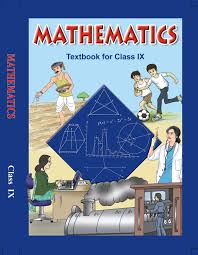
Top Block 1
Exercise 10.6
Question : Prove that the line of centres of two intersecting circles subtends equal angles at the two points of intersection.
Answer :
Given : Two intersecting circles, in which OO′ is the line of centres and A and B are two points of intersection.
To prove: ∠OAO′ = ∠OBO′
Construction: Join AO, BO, AO′ and BO′.
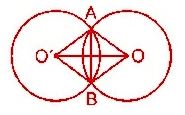
Proof: In ∆AOO′ and ∆BOO′, we have
AO = BO [Radii of the same circle]
AO′ = BO′ [Radii of the same circle]
OO′ = OO′ [Common]
So, ∆AOO′ ≅∆BOO′ [by SSS axiom]
⇒ ∠OAO′ = ∠OBO′ [by CPCT]
Hence, the line of centres of two intersecting circles subtends equal angles at the two points of
intersection.
Question : 2: Two chords AB and CD of lengths 5 cm and 11 cm respectively of a circle are parallel to each other and are on opposite sides of its centre.
If the distance between AB and CD is 6 cm, find the radius of the circle.
Answer :
Let O be the centre of the circle and let its radius be r cm.
Draw OM ⊥ AB and OL ⊥ CD.
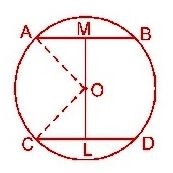
Mddle block 1
Then, AM = AB/2 = 5/2 cm
and, CL = CD/2 = 11/2 cm
Since, AB || CD, it follows that the points O, L, M are collinear and therefore, LM = 6 cm.
Let OL = x cm. Then OM = (6 – x) cm
Join OA and OC. Then OA = OC = r cm.
Now, from right-angled ∆OMA and ∆OLC, we have
OA2 = OM2 + AM2 and OC2 = OL2 + CL2 [By Pythagoras Theorem]
⇒ r2 = (6 – x) 2 + (5/2) 2 ………(i)
and r2 = x2 + (11/2) 2 ………… (ii)
From equation 1 and 2, we get
⇒ (6 – x) 2 + (5/2) 2 = x2 + (11/2) 2
⇒ 36 + x2 – 12x + 25/4 = x2 + 121/4
⇒ -12x = 121/4 – 25/4 – 36
⇒ -12x = 96/4 – 36
⇒ -12x = 24 – 36
⇒ 12x = – 12
⇒ x = 1
Substituting x = 1 in equation (i), we get
r2 = (6 – x) 2 + (5/2) 2
⇒ r2 = (6 – 1) 2 + (5/2) 2
⇒ r2 = 52 + 25/4
⇒ r2 = 25 + 25/4
⇒ r2 = 125/4
⇒ r = √(125/4)
⇒ r = 5√5/2
Hence, radius r = 5√5/2 cm.
Question : 3: The lengths of two parallel chords of a circle are 6 cm and 8 cm. If the smaller chord is at distance 4 cm from the centre, what is the distance of the other chord from the centre?
Answer :
Let PQ and RS be two parallel chords of a circle with centre O.
We have, PQ = 8 cm and RS = 6 cm.
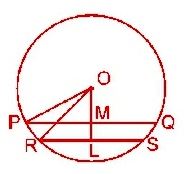
Draw perpendicular bisector OL of RS which meets PQ in M.
Since PQ || RS, therefore, OM is also perpendicular bisector of PQ.
Also, OL = 4 cm and RL = RS/2
⇒ RL = 3 cm
and PM = PQ/2
⇒ PM = 4 cm
In ∆ORL, we have
OR2 = RL2 + OL2 [Pythagoras theorem]
⇒ OR2 = 32 + 42 = 9 + 16
⇒ OR2 = 25
⇒ OR = 5 cm
Since OR = OP [Radii of the circle]
⇒ OP = 5 cm
Now, in ∆OPM
OM2 = OP2 – PM2 [Pythagoras theorem]
⇒ OM2 = 52 – 42 = 25 – 16 = 9
⇒ OM = √9 = 3 cm
Hence, the distance of the other chord from the centre is 3 cm.
Question : 4: Let the vertex of an angle ABC be located outside a circle and let the sides of the angle intersect equal chords AD and CE with the circle.
Prove that ∠ABC is equal to half the difference of the angles subtended by the chords AC and DE at the centre.
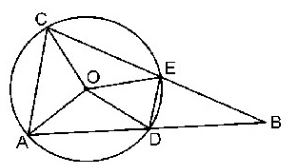
Answer :
Given: Two equal chords AD and CE of a circle with centre O. When meet at B when produced.
To Prove: ∠ABC = (∠AOC –∠DOE)/2
Proof: Let ∠AOC = x, ∠DOE = y, ∠AOD = z
∠EOC = z [Equal chords subtends equal angles at the centre]
⇒ x + y + 2z = 360 [Angle at a point] ………..(i)
OA = OD
⇒ ∠OAD = ∠ODA
Now in DOAD, we have
∠OAD + ∠ODA + z = 1800
⇒ 2∠OAD = 1800– z [Since ∠OAD = ∠OBA]
⇒ ∠OAD = 900– z/2 …………… (ii)
Similarly ∠OCE = 90°– z/2 …….. (iii)
⇒ ∠ODB = ∠OAD + ∠ODA [Exterior angle property]
⇒ ∠OEB = 900– z/2 + z [From equation (ii)]
⇒ ∠ODB = 900 + z/2 …………. (iv)
Also, ∠OEB = ∠OCE + ∠COE [Exterior angle property]
⇒ ∠OEB = 900– z/2 + z [From equation (iii)]
⇒ ∠OEB = 900 + z/2 ………. (v)
Also, ∠OED = ∠ODE = 900– y/2 ……… (vi)
From equation (iv), (v) and (vi), we have
∠BDE = ∠BED = 900 + z/2 – (900– y/2)
⇒ ∠BDE = ∠BED = 900 + z/2 – 900 + y/2
⇒ ∠BDE = ∠BED = (y + z)/2
⇒ ∠BDE = ∠BED = y + z …….. (vii)
So, ∠BDE = 1800– (y + z)
⇒ ∠ABC = 1800– (y + z) ……… (viii)
Now, (y – z)/2 = (3600 – y – 2z – y)/2 = 1800 – (y + z) …….. (ix)
From equation (viii) and (ix), we get
∠ABC = (x – y)/2
Question : 5: Prove that the circle drawn with any side of a rhombus as diameter, passes through the point of intersection of its diagonals.
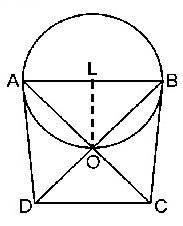
Answer :
Given: A rhombus ABCD whose diagonals intersect each other at O.
To prove: A circle with AB as diameter passes through O.
Proof: ∠AOB = 900 [Diagonals of a rhombus bisect each other at 900]
⇒ ∆AOB is a right triangle right angled at O. ⇒ AB is the hypotenuse of A B right ∆ AOB.
⇒ If we draw a circle with AB as diameter, then it will pass through O. because angle is a
Semicircle is 900 and ∠AOB = 900
Question : 6: ABCD is a parallelogram. The circle through A, B and C intersect CD (produced if necessary) at E. Prove that AE = AD.
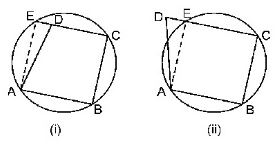
Answer :
Given: ABCD is a parallelogram.
To Prove: AE = AD.
Construction: Draw a circle which passes through ABC and intersect CD (or CD produced) at E.
Proof: For figure (i), we get
∠AED + ∠ABC = 1800 [Linear pair] ……… (i)
But ∠ACD = ∠ADC = ∠ABC + ∠ADE
⇒∠ABC + ∠ADE = 1800 [From figure (ii)] ………. (ii)
From equation (i) and (ii), we get
∠AED + ∠ABC = ∠ABC + ∠ADE
⇒ ∠AED = ∠ADE
⇒ ∠AD = ∠AE [Sides opposite to equal angles are equal]
Similarly we can prove for Fig (ii) also.
Question : 7: AC and BD are chords of a circle which bisect each other. Prove that (i) AC and BD are diameters, (ii) ABCD is a rectangle.
Answer :
Given: A circle with chords AB and CD which bisect each other at O.
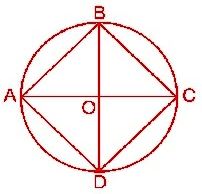
To Prove: (i) AC and BD are diameters
(ii) ABCD is a rectangle.
Proof: In ∆OAB and ∆OCD, we have
OA = OC [Given]
OB = OD [Given]
∠AOB = ∠COD [Vertically opposite angles]
⇒ ∆AOB ≅∠COD [SAS congruence]
⇒ ∠ABO = ∠CDO and ∠BAO = ∠BCO [CPCT]
⇒ AB || DC ……….. (i)
Similarly, we can prove BC || AD ……….. (ii)
Hence, ABCD is a parallelogram.
But ABCD is a cyclic parallelogram.
So, ABCD is a rectangle. [Proved in Q. 12 of Ex. 10.5]
⇒ ∠ABC = 900 and ∠BCD = 900
⇒ AC is a diameter and BD is a diameter [Angle in a semicircle is 900]
Question : 8: Bisectors of angles A, B and C of a triangle ABC intersect its circumcircle at D, E and F respectively. Prove that the angles of the triangle DEF are 900 – A/2, 900 – B/2 and 900 – C/2.
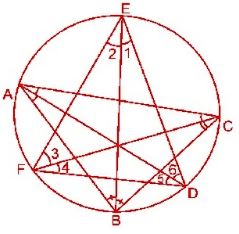
Answer :
Given : ∆ABC and its circumcircle. AD, BE,
CF are bisectors of ∠A, ∠B, ∠C respectively.
Construction : Join DE, EF and FD.
Proof : We know that angles in the same
segment are equal.
So, ∠5 = ∠C/2 and ∠6 = ∠B/2 ………..(i)
∠1 = ∠A/2 and ∠2 = ∠C/2 ……….(ii)
∠4 = ∠A/2 and ∠3 = ∠B/2 ……..(iii)
From equation (i), we have
∠5 + ∠6 = ∠C/2 + ∠B/2
⇒ ∠D = ∠C/2 + ∠B/2 …………(iv) [Since ∠5 + ∠6 = ∠D]
But ∠A + ∠B + ∠C = 1800
⇒ ∠B + ∠C = 1800–∠A
⇒ ∠B/2 + ∠C/2 = 900–∠A/2
So, equation (iv) becomes,
∠D = 900–∠A/2
Similarly, from equation (ii) and (iii), we can prove that
∠E = 900–∠B/2 and ∠F = 900–∠C/2
Question : 9: Two congruent circles intersect each other at points A and B. Through A any line segment PAQ is drawn so that P, Q lie on the two circles. Prove that BP = BQ.
Answer :
Given: Two congruent circles which intersect at A and B. PAB is a line through A.
To Prove: BP = BQ.
Construction: Join AB.
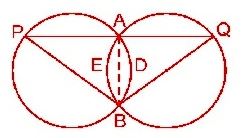
Proof: AB is a common chord of both the circles.
But the circles are congruent.
⇒ arc ADB = arc AEB
⇒ ∠APB = ∠AQB [Angles subtended]
⇒ BP = BQ [Sides opposite to equal angles are equal]
Question : 10: In any triangle ABC, if the angle bisector of ∠A and perpendicular bisector of BC intersect, prove that they intersect on the circumcircle of the triangle ABC.
Answer :
Let angle bisector of ∠A intersect circumcircle of ∆ABC at D.

Now, join DC and DB.
∠BCD = ∠BAD [Angles in the same segment]
⇒ ∠BCD = ∠BAD = ∠A/2 [AD is bisector of ∠A] ……..(i)
Similarly ∠DBC = ∠DAC = ∠A/2 ………….. (ii)
From equation (i) and (ii), we get
∠DBC = ∠BCD
⇒ BD = DC [sides opposite to equal angles are equal]
⇒ D lies on the perpendicular bisector of BC.
Hence, angle bisector of ∠A and perpendicular bisector of BC intersect on the circumcircle of
∆ ABC.
